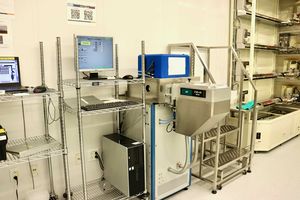Difference between revisions of "Oxford PlasmaLab 100 PECVD"
Jump to navigation
Jump to search
| Line 19: | Line 19: | ||
The QNF Oxford Instruments PlasmaLab System 100 Plasma Enhanced Chemical Vapor Deposition (PECVD) tool is used to deposit a variety of thin-film materials at relatively modest temperatures on a variety of substrate materials. The tool utilizes an RF generator to deposit thin films at temperatures lower than traditional chemical vapor deposition systems. | The QNF Oxford Instruments PlasmaLab System 100 Plasma Enhanced Chemical Vapor Deposition (PECVD) tool is used to deposit a variety of thin-film materials at relatively modest temperatures on a variety of substrate materials. The tool utilizes an RF generator to deposit thin films at temperatures lower than traditional chemical vapor deposition systems. | ||
| − | |||
===== Applications ===== | ===== Applications ===== | ||
Revision as of 10:45, 7 April 2022
 |
|
| Tool Name | Oxford PlasmaLab 100 PECVD |
|---|---|
| Instrument Type | Deposition |
| Staff Manager | Sam Azadi |
| Lab Location | Bay 1 |
| Tool Manufacturer | Oxford |
| Tool Model | PlasmaLab 100 |
| NEMO Designation | {{{NEMO_Designation}}} |
| Lab Phone | XXXXX |
| SOP Link | QNF SOP |
Description
The QNF Oxford Instruments PlasmaLab System 100 Plasma Enhanced Chemical Vapor Deposition (PECVD) tool is used to deposit a variety of thin-film materials at relatively modest temperatures on a variety of substrate materials. The tool utilizes an RF generator to deposit thin films at temperatures lower than traditional chemical vapor deposition systems.
Applications
- Silicon dioxide deposition
- Silicon nitride deposition
- Amorphous silicon deposition
Allowed material in PECVD System
- Si, SixNy, SiO2, SOI
- Hard masks compatible with process temperature
Resources
SOPs & Troubleshooting